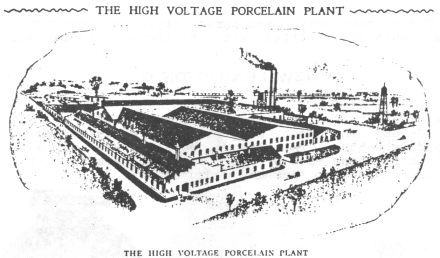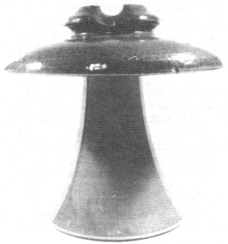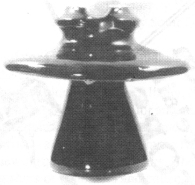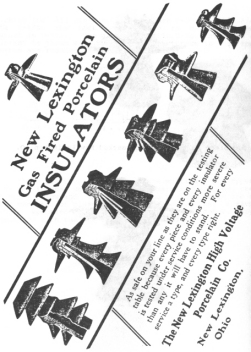Porcelain Insulator News
by Elton Gish, NIA #41
Reprinted from "Crown Jewels of the Wire", March 1988, page 7
Rick Soller (NIA #2958) has made another visit to see his relatives in New
Lexington, Ohio and he took time out to continue his research into the history
of the New Lexington High Voltage Porcelain Company. We are very grateful and
fortunate for Rick's interest in research and for his sharing the fruits of his
labors. He has spent many countless hours going over microfilms and historical
records with much success in piecing together the history of this company. For
many of us industrial archeologists, it is rewarding to find new historical
facts about the early part of our hobby. It is very similar to finding a rare
threadless or other goodie out in the field where they were used.
Rick dug through property records this time and they tell a very interesting
story. On June 6, 1903 the New Lexington High Voltage Porcelain Company bought
the land for their plant from T. J. Tracy and his wife.
The operations was defunct by 1912. On October 5, 1912, G. S. Courtright, a
trustee of the corporation, bought the property from the company through a
sheriff's sale as the result of action by the Perry County bank to recover a
mortgage on the plant. He paid $4334 for the property. Another trustee, Asberry
Garlinger, lost over $23,000 that he had loaned to the company for a second
mortgage.
The record of the execution of the sale described the contents of the
factory: "2000 fifty-thousand volt insulators; 700 twenty-seven thousand
volt insulators; 600 thirty thousand volt insulators; 12,000 four to ten
thousand volt insulators; 600 thirteen thousand volt insulators; 25 tons of
Tennessee ball clay No. 3; 15 tons of Tennessee ball clay No.7; 40 tons of
Georgia china clay; 15 tons of feldspar clay; 5 tons of fluid clay; 57 barrels of King's Potter Plaster." That is a total of 21,000
insulators.
George S. Courtright, et al, then sold the property to Consumer Insulator Co.
for one dollar on November 5, 1914. This was a simple paper shuffle and possibly
to avoid paying property taxes on an idle plant.
Then another paper shuffling on December 8, 1916 when the Consumers Insulator
Co. was sold to Virginia Potteries Co., a corporation of Charleston, WV, for one
dollar. On March 23, 1918, the Virginia Potteries Co. was adjudged bankrupt.
On June 19, 1918, the property was sold to the General Porcelain Co. (formed
in 1913) for $7750. That price was a bargain as all of the stock and inventory
of the New Lexington plant was still in place since the plant closing in 1912.
The property included: "One lot of moulds; one stock of electric
insulators, approximately 50,000; one lot of soup bowls, approximately 5,000
finished and 3,500 partly finished; one lot of raw material, including 190 tons
of various kinds of clay; 167 bushels of plaster of paris; 3,000 pounds of
outside oxide magnesia; six bushels of whiting and 125 gallons of oil."
After General Porcelain moved all the material across the river to their
Parkersburg, WV plant, they sold the property on July 25, 1918 to two men under
the condition that the property would not be used to manufacture electrical
porcelain or door knobs for five years. The property is currently a used car
lot.
General Porcelain Co. surely made out like a bandit and it immediately
allowed them to rapidly enter into the high voltage insulator market. The large
stock of finished insulators were cataloged and sold, mostly with the unchanged
New Lexington catalog numbers, together with their own insulators manufactured
at Parkersburg. It is unknown whether General Porcelain had already commenced
manufacturing wet process pin types before the acquisition of the New Lexington
plant, but General Porcelain's first general catalog of pin types was dated
1923.
Rick also sent a copy of a page (reprinted on the next page) from The Book of
Perry County: An Historical Industrial Portfolio originally published in 1909.

This large and thriving enterprise of New Lexington began business in 1903,
and since that time has been regarded as one of our leading industries. The
company is engaged in the manufacture of high potential insulators for the
transmission of great power. Since its operation the company has equipped with
insulators some of the largest power plants in the United States and Canada.
Among these may be mentioned the Niagara and Lock Port Power Plant, after all
other companies had failed to produce insulators of the required electrical and
mechanical strength. Also the Niagara Power Plant on the Canadian side. It has
furnished more insulators to the Pacific Coast Power Plants than all its
competitors. Abundant testimonials attest that the insulators manufactured by
this company are the best that can be produced at the present state of the art.
The process of making is a secret, and the material is composed of a special
clay, combined with clays from other states.
The projectors and owners are all local men noted for their business ability
and acumen. The Board of Directors is composed of: A. Bringardner, Asbery
Garlinger, Dr. G. S. Courtright, Judge Maurice H. Donahue and Dr. J. G. McDougal.
Judge Donahue is president and Mr. T. J. Weiland secretary and treasurer. Mr.
Guy G. Jackson is the electrical engineer and manager of the sales department.
Mr. Brown is foreman. The works are kept running most of the time, and afford
profitable employment to a large number of our people.
There have only been three styles of unipart pin type insulators reported
with the incuse New Lexington

marking and all are rare. These are U-552, U-746 and Sim U-966. The most
common style is U-746 and the rarest is U-552. The glazewelded Sim U-966 style
is a variant to those made by other manufacturers in that the skirts are rounded
(see the photo below).
There are three known two-piece multipart pin types with the incuse New
Lexington, O. marking and they are pictured below and on the following page.
There are a wide variety of glazes from a light buff tan, a rich finely speckled
brown or a mottled black color. Any insulator with the New Lexington marking is
rare.


Two piece multiparts each marked New Lexington, O.


Medium Image (186 Kb)
Large Image (381 Kb)
This ad is reprinted from the May 27, 1909 issue of Electrical World.
| 